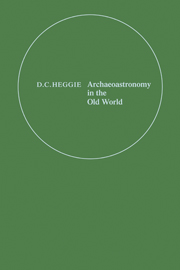Book contents
- Frontmatter
- Contents
- PREFACE
- LIST OF CONTRIBUTORS
- INVITED PAPERS
- CONTRIBUTED PAPERS
- A SURVEY OF THE BARBROOK STONE CIRCLES AND THEIR CLAIMED ASTRONOMICAL ALIGNMENTS
- OBSERVATIONS AT KINTRAW
- DECODING THE CALLANISH COMPLEX - A PROGRESS REPORT
- ASTRONOMY AND STONE ALIGNMENTS IN S.W. IRELAND
- STONE RINGS OF NORTHERN POLAND
- ASTRONOMICAL ORIENTATION OF NEOLITHIC SITES IN CENTRAL EUROPE
- STONE CIRCLE GEOMETRIES: AN INFORMATION THEORY APPROACH
- INVITED PAPER
- INDEX
DECODING THE CALLANISH COMPLEX - A PROGRESS REPORT
Published online by Cambridge University Press: 05 November 2011
- Frontmatter
- Contents
- PREFACE
- LIST OF CONTRIBUTORS
- INVITED PAPERS
- CONTRIBUTED PAPERS
- A SURVEY OF THE BARBROOK STONE CIRCLES AND THEIR CLAIMED ASTRONOMICAL ALIGNMENTS
- OBSERVATIONS AT KINTRAW
- DECODING THE CALLANISH COMPLEX - A PROGRESS REPORT
- ASTRONOMY AND STONE ALIGNMENTS IN S.W. IRELAND
- STONE RINGS OF NORTHERN POLAND
- ASTRONOMICAL ORIENTATION OF NEOLITHIC SITES IN CENTRAL EUROPE
- STONE CIRCLE GEOMETRIES: AN INFORMATION THEORY APPROACH
- INVITED PAPER
- INDEX
Summary
Abstract. Recent research, both archaeological and astronomical, at megalithic sites at Callanish, Carloway and Bernera is described. Evidence for prehistoric lunar observation at Callanish area sites continues to accumulate; a moon re-gleam phenomenon occurred on the horizon at the standstill at most sites so far studied. Difficulties are experienced in astronomical studies at sites which have not been investigated archaeologically.
ARCHAEOASTRONOMY AT CALLANISH
The Standing Stones of Callanish on the Isle of Lewis have been referred to, with some justification, as the ‘Stonehenge of the Hebrides’. They hold a special place in the history of archaeoastronomy. Quasi-astronomical functions were ascribed to the site by at least five authors in the 18th and 19th centuries (Toland 1726; Headrick 1808; MacCulloch 1824; Callender 1854; Kerr 1873). The archaeoastronomers Lewis (1900) and Lockyer (1909) also referred to Callanish.
In 1912, Somerville was the first to complete on-site astronomical research and he identified an alignment to a lunar extreme. This was the first suggestion that prehistoric man in Britain had established lunar alignments. Somerville's paper, and a visit to Callanish in 1934, were the original inspirations for Thom's detailed studies on megalithic sites (e.g. Thom 1967; Thom 1971; Thom & Thom 1978).
Hawkins' computer studies of Stonehenge (1963) were followed by a similar study of Callanish (Hawkins 1965). Ruggles and his colleagues' objective methods for determining indicated declinations were given an initial trial at the sites around Callanish (Cooke etal. 1977).
- Type
- Chapter
- Information
- Archaeoastronomy in the Old World , pp. 191 - 204Publisher: Cambridge University PressPrint publication year: 1982



